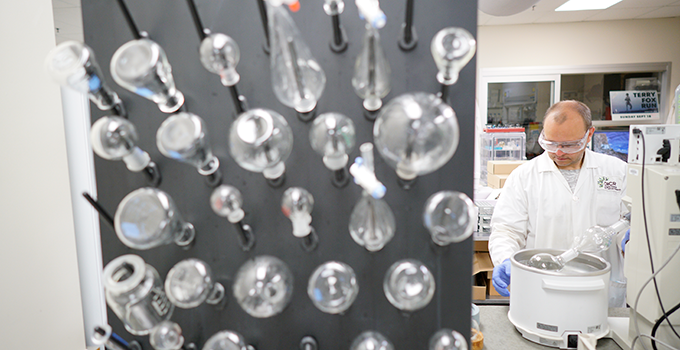A study led by OICR drug discovery researchers could pave the way for new treatment options for blood cancers.
OICR researchers have discovered a new way to target proteins that drive leukemia and other cancers that could help generate new, more efficient drugs to treat them.
In a study published in Nature Communications, OICR Drug Discovery scientists created small molecules called PROTACs that trigger a cell’s natural waste-disposal processes in order to eliminate a protein called WDR5 — a well-known driver of multiple cancers.
The work builds on OICR’s rich portfolio of drug discovery research into WDR5, including creating a first-in-class WDR5 inhibitor that attracted a major industry investment in 2019.
This new study leverages a different pathway to degrade WDR5 that involves an understudied protein called DCAF1 which functions as a ‘receptor’ for proteins that a cell is ready to target for disposal. The PROTACs researchers created for the study bind to WDR5 on one side and DCAF1 on the other, effectively telling a cell to destroy WDR5.
“We have reported an efficient way to eliminate WDR5, which is a key target for the development of cancer therapeutics,” says Dr. Masoud Vedadi, OICR Senior Scientific Advisor and the senior author of the Nature Communications paper.
Before this study, very few researchers had used DCAF1 to target cancer-linked proteins. But Vedadi says his team’s findings are promising for few key reasons.
For one, DCAF1 is important to many different cellular processes. Therefore, it’s unlikely to be mutated or downregulated, which can happen to other receptor proteins. That means therapeutics that use DCAF1 to knock out a target protein would be effective for longer than drugs that exploit other pathways.
“DCAF1 is a highly attractive, sustainable system for getting rid of proteins because the cell needs it to survive,” Vedadi says.
The study was also the first to publish the crystal structures of DCAF1, PROTACs and WDR5 bound together — known as ‘ternary complexes’ — which showed that DCAF1 proteins have dynamic, flexible ‘loops’ that latch onto a PROTAC and the target protein and ensure they stay securely bound.
Vedadi says that makes DCAF1 even more effective at knocking out unwanted proteins and could have implications for other drug targets beyond WDR5.
While the study was the result of a large and fruitful collaboration involving OICR, the University of Toronto and Princess Margaret Cancer Centre, much of the science was done in-house at OICR. Vedadi says that’s a testament to the diverse expertise on the Institute’s Drug Discovery team.
“We have a unique set of expertise in house at OICR that makes the flow of science highly efficient and enables us to make game-changing discoveries,” he says.



